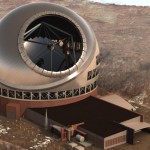While science observations may be almost a decade away, the science possibilities of the Thirty Meter Telescope are already eagerly anticipated by astronomers. In the attempt to answer many of the basic questions of our universe, the limitations of the existing telescopes have become apparent. The eight and ten meter telescopes that represent the forefront of astronomy today are reaching their limit, a limit the research astronomy community is ready to step past.

One thing was clear from the science presentations… The science case for the TMT is compelling. The sheer size of the new telescope will allow observation of the early universe that is just out of reach of the current generation of large telescopes. The thirty meter primary mirror will provide significant advantages even over the next generation of space telescopes in resolution and flexibility of operation. The excellent site available on Mauna Kea allows advantages over the selected site for the European E-ELT in Chile.
While the goal of the conference is to look ahead. It is interesting that what is being presented is a wonderful summary of where current research stands today. In the effort to detail what research could be accomplish with TMT, the astronomers succinctly cataloged the state of current research as it is limited by today’s instruments and telescopes.
Much of the first day discussion was focused on the possibilities of observing the very early universe, the first stars and galaxies that formed in the era just after the big bang. Current telescopes can observe a few tantalizing glimpses of this era, just enough to show astronomers what they do not know about the formation of our universe. A few massive galaxies bright enough to be seen across the gulf of time, a few fainter galaxies that are luckily aligned with closer massive galaxy clusters. Clusters that form gravitational lenses that allow us to peer through a keyhole into the dim past. Astronomer have used every trick they can muster to allow observation of this first era. The TMT will open the door into this first era of stars, allow real study of the beginning of what we see around us today.
Planning for the TMT is in the final stages, where the capabilities of the telescope and the instruments can be forecast with reasonable assurance that those goals will be met. Astronomers can use the design data of the telescope to simulate exposures and signal to noise ratios of the data, on targets they can just barely see today. This sort of planning is critical to the astronomy community, it may be another ten years before science observations begin, but when they do the astronomers will be ready to use the telescope to its fullest capability.
This sort of feedback is critical to the engineers as well. As instruments pass through final development, it is important to know what capabilities are most valuable, what to prioritize when the final design is produced. Questions of spectral resolutions, throughput and exposure times are often heard in the discussions.
Through conferences like this one, the astronomy community will know what to expect when the new telescope comes online around 2022. They will be ready to push forward our understanding of the universe. We know what to expect. But, as Andrea Ghez reminded us, we must “Expect the unexpected!”. Many of the discoveries made by Keck and the other great telescopes of the current generation were completely unexpected. It is likely that the universe still has a few surprises for us.

